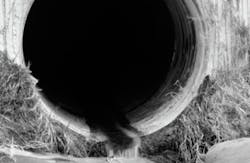STEPP is a workgroup dedicated to the investigation of a national stormwater testing and evaluation program. STEPP is an acronym for “Stomwater Testing and Evaluation for Products and Practice.”
Time to STEPP Up
While stormwater runoff has been regulated for more than two decades in the United States, responsibility for product testing to provide municipalities and other governed entities the tools they need to manage stormwater effectively has been fragmented among regional and state testing programs.
“Lack of third-party verification in the performance of stormwater products and practices has created a bit of a ‘Wild West’ situation in the sector, where claims can be made on efficacy on no or little basis,” said Seth Brown, Water Environment Federation (WEF) Stormwater Program and Policy Director. “This has created an atmosphere of distrust in the field. This is not to say that stormwater products and practices don’t work—many of them work, and work well, but the lack of objective data on performance may allow under-performers to thrive.”
READ ALSO: Is Lake Erie's Algae-Bloom Contamination Problem a Sign of Things to Come?
Shedding light on the performance of products and practices using a credible, third-party testing and verification program using consistent protocols is the core aim of the STEPP program. The previous national testing system, the EPA Environmental Technology Verification (ETV) program, ended in 2012, which left a void in national-level leadership on product testing in the stormwater sector. That same year, WEF convened a meeting at WEFTEC 2012, which included approximately 25 officials from EPA, consultants, NGOs, and representatives from stormwater manufacturers, to discuss this topic. The participants of this meeting formed STEPP, which is led by a steering committee of 10 members and a chair.
STEPP White Paper
The STEPP workgroup steering committee released a white paper in February 2014 titled “Investigation into the Feasibility of a National Testing and Evaluation Program for Stormwater Products and Practices,” recommending a national testing and evaluation program for stormwater products and practices.
According to Brown, “the goal of a national program would be to meet the growing need for affordable and effective stormwater management infrastructure and to overcome the hurdles in the sector that restrain innovation in stormwater product and practice technology development.”
The 40-page white paper outlines the challenges of developing a national program and possible solutions.
“Challenges include the variability in climate, soils and other state- or region-specific factors affecting stormwater runoff quality and quantity, as well as differing regulatory and water quality drivers and programs across the country,” Brown said. “With that said, the basic processes to address stormwater runoff (infiltration, filtration, etc.) are the same regardless of climate, and varying climatic conditions can be simulated in a laboratory setting.
“WEF has been working with the National Institute of Standards and Technology (NIST) to harmonize stormwater testing and evaluation procedures. Initial investigation has found that while some variability between states or regions in testing/verification programs is reasonable, the amount of variability that currently exists seems to be arbitrary.”
Next STEPPs
Over the next year, Brown said the STEPP workgroup and steering committee will be focusing on putting “meat on the bones” of the white paper. “This will include developing a sustainable business plan for a national program along with some options for program architecture and leadership,” Brown said. An effort to survey the states and their needs is also currently underway.
To read the full STEPP white paper, visit www.wef.org/stepp.
Amy W. Richardson is the managing editor of Flow Control. She can be reached at [email protected]. Connect with Amy on LinkedIn.



